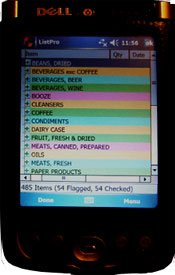 What advice would you give women What advice would you give women
in setting up their galleys, in preparing to cook aboard?
When we first started cruising, we were so proud of the satisfying meals that we cooked aboard that we would record each dinner in the log. We no longer do that, but still find that being aboard increases our enjoyment of the food we prepare and eat. There's time to cook and local foods to explore, and when it's time to eat, the view from our dinner table usually can't be beat. So take a little time to prepare a comfortable, efficient cooking area.
Plan the various spaces aboard that you will need for cooking and storing provisions. Often you can make little modifications that seem to make a huge difference in how much useable space you have.
Counter/working space
I often wish I had more, especially since my counter space doubles as the lids to my fridge, freezer, and pot locker. So, on 2 of my boats we added extra counter space. On my tiny Alberg 30, we added a small hinged shelf that I could open up when I needed extra food preparation space. On my Whitby 42, we added a narrow shelf with deep fiddles above the sink that seemed to double my working space.
|
My galley on Hale Kai with spice racks, fan, opening ports. |
On all my boats, we have had spice racks and shelves mounted on the walls that allowed me to keep utensils, spices, and some of my most commonly used cooking items right at hand where I never even have to set them on the counter.
Storage space
To make the most of your storage consider some of these:
-
Wall-mounted storage rack for dishes
We found one that fit our compact Corelle dishes plus stored our daily cutlery and utensils. Easy to grab and put away! Underway we would wedge an extra pot holder and towel to keep the dishes from moving.
-
Hammocks are great for storing perishable items that you want to make sure to eat quickly as well as lightweight bulky items like bread, chips and crackers.
-
Oven and microwave
We always store pots and pans in the oven and in the microwave too, especially since the microwave gets so little use out cruising.
-
The choice storage spaces near the galley
I've never had a galley that came anywhere close to storing all the provisions we need to carry for cruising. So look around (and even create) nearby suitable spaces for storage. The food you carry aboard is going to get used more frequently than many spare parts. Store your food items in the easily accessible lockers near the galley and squirrel away the infrequently needed spare parts in the less-accessible storage locations. To make it more palatable to your mate, offer to make a detailed inventory of the location of all those spare parts.
-
Revamp poorly used spaces
On my Whitby 42, we had a huge space behind the settee cushions that was almost useless. We got rid of the small cubbyhole-like openings and added shelves with sliding plexiglas doors so that I could see everything. I used bins and big plastic containers (including large plastic restaurant mayonnaise jars) to store bulk items, and I could see everything through the plexiglas. I thought it was wonderful. Visit boats similar to yours, they may have come up with a great way to use hidden space. That's how we discovered that the space under the floor of the nav station would make a great drinks locker. We hinged the floorboard under the nav and gained a great storage space.
-
The bottom of the fridge and freezer
Our fridge and freezer compartments are deep and each have a compartment at the very bottom under the shelf. We use that area to store extra bags of flour, coffee, yeast, chocolate, etc. We use the vacuum sealer to seal full bags of flour. They stay dry and cool.
Keeping inventory
 |
Food inventory on my PDA |
Over time I have tried many different methods to keep track of my provisions from index cards for various compartments to computer spreadsheets.
My current method is working better than my previous efforts but it's pretty geeky.
I have a little PDA that I use for a number of different purposes. I keep my inventory in a list-making program on the PDA which syncs with the computer. this is handy because I can look at or update my inventory on the PDA without having to turn on the computer. I seldom bother to print it out unless I am making a big provisioning run.
Often, I will carry my little PDA to the supermarket with me, in case I run into some find and am unsure how well stocked I am on that item. I also use a marks-a-lot to write the purchase date on food items (cans, boxes) when I buy them so I can use the oldest items first.
If you are nerdy too and want a copy of my food inventory file, email me. |